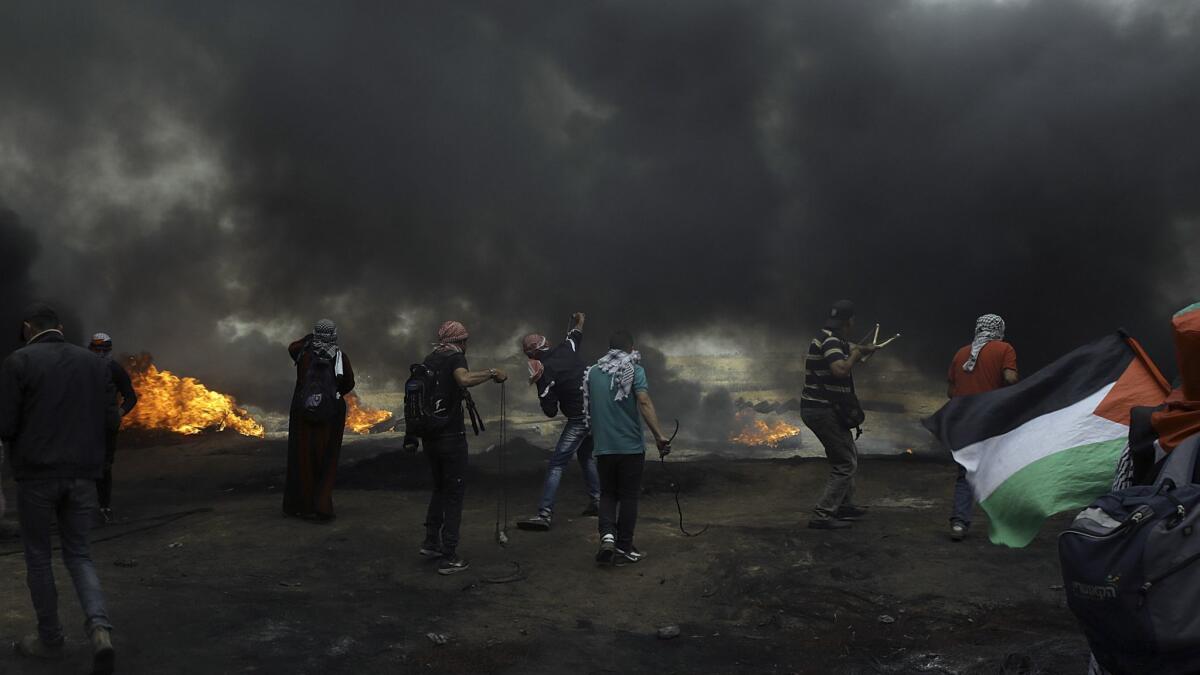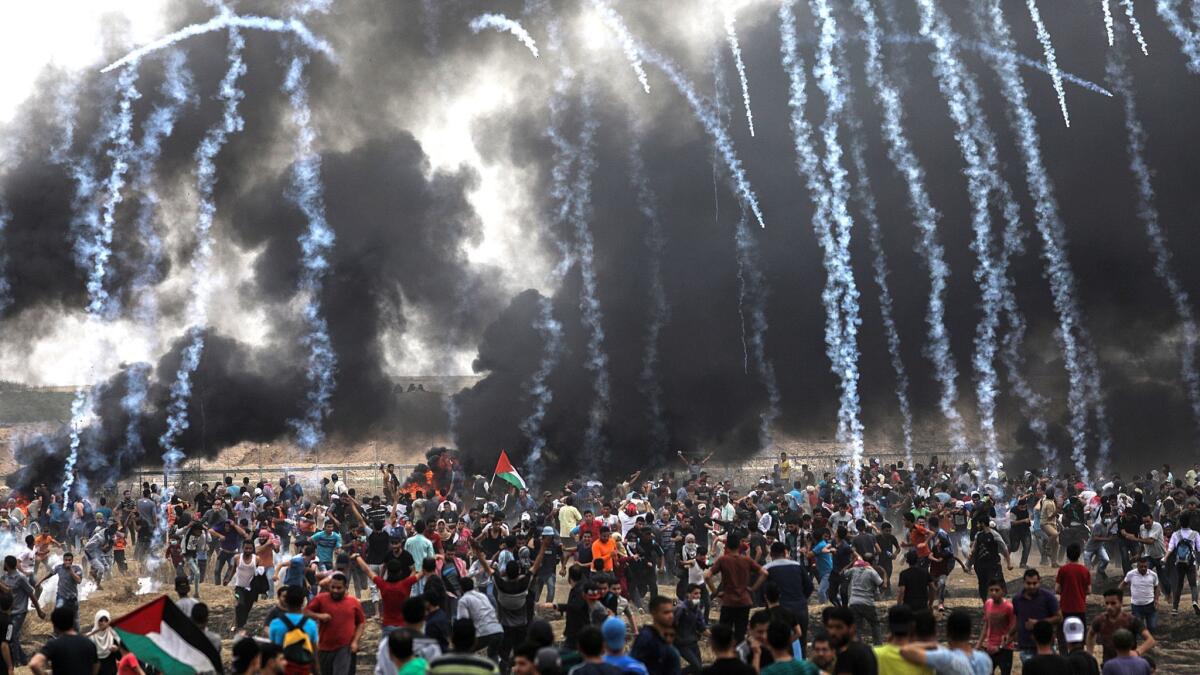Condemned for Gaza shootings, Israel says it is only defending its border from ‘parade of terror’

- Share via
Reporting from Nahal Oz, Israel — After weeks of Palestinian demonstrations on the Gaza Strip border, Israel is facing global condemnation for answering the agitators with tear gas and bullets.
Israel, though, sees its action far differently: defending its border from a lawless terrorist organization.
“It’s easy to criticize us from the comforts of a faraway couch,” says a senior Israeli military commander during a tour of the border. Army regulations stipulate that senior officers never use their name when speaking publicly.
If the tiny, tidy community of Nahal Oz — population 400 — wasn’t located just half a mile from the volatile Gaza border, Israel believes its aggressive efforts to defend the towns and communities in the borderlands would be better understood. How would America, they wonder, choose to defend itself against an enemy militia pelting it with mortar fire and rockets and digging tunnels so terrorists could infiltrate the country.
But after six straight Fridays of Palestinian demonstrations on the Gaza border, Israel is now struggling to convince the world that its response is proportional.
Forty-eight Palestinians, including two journalists and at least two teenagers, have been killed in the border clashes and thousands more have been injured, many with bullet wounds to the legs.

Gaza, a dense territory of 2 million residents wedged among Israel, Egypt and the Mediterranean Sea, has endured an onerous blockade since 2007, when the Islamic militant group Hamas seized it from the Palestinian Authority in a bloody coup.
On April 7, a day after the photographer Yasser Murtaja, 30, was shot and killed during the second week of protests, Christophe Deloire, secretary-general of Reporters Without Borders, accused Israel of targeting journalists.
“He was obviously the victim of an intentional shot,” Deloire said in a tweet, pointing out the photographer was wearing a vest that clearly said “Press.”
The Israeli army said that it was “dealing with tens of thousands of people approaching the [border] fence, all instigated by Hamas,” and that it “does not deliberately target journalists.”
The army said the photographer’s death is under investigation, though no findings have been released in the intervening five weeks.
On April 20, 15-year-old Mohammed Ibrahim Ayoub was killed in the border riots. A widely circulated video appeared to show he was shot in the head.
“It is OUTRAGEOUS to shoot at children!” tweeted Nickolay E. Mladenov, the United Nations’ special coordinator for the Middle East Peace Process and a former defense minister of Bulgaria. “How does the killing of a child in #Gaza today help #peace? It doesn’t! It fuels anger and breeds more killing. #Children must be protected from #violence, not exposed to it, not killed!”
The U.S. has so far stood alone in focusing criticism on the Palestinians.
Jason Greenblatt, President Trump’s special representative for international negotiations, urged protest organizers to march peacefully and denounced “leaders and protesters who call for violence or who send protesters — including children — to the fence, knowing that they may be injured or killed.”
Israeli Defense Minister Avigdor Lieberman said, “Hamas sends terrorists under the guise of civilians to harm our sovereignty, and the world presents this parade of terror as a civil protest.”
Some in Israel also question the use of lethal force to quell protesters.
Two weeks ago, Israel’s Supreme Court heard arguments in a case brought against the state by five Israeli human rights groups and the Gaza-based Al Mezan Center for Human Rights, arguing that the laws of armed conflict don’t apply regarding the Gaza riots, and that the army’s rules of engagement don’t meet “international standards for law enforcement.”
“Lethal force against unarmed civilians who do not pose a danger is illegal,” says Michael Sfard, a lawyer for the organizations.
Israelis living along the border, and the troops there to protect them, dispute the characterization. “We face armed, dangerous rioters whose aim is to harm civilians,” the senior officer says. “There is nothing peaceful about this.”
Nahal Oz is no stranger to spillover violence from Gaza. The last Israeli civilian victim of the 2014 war between Hamas and Israel, in which more than 2,000 Palestinians and nearly 80 Israelis died, was Nahal Oz resident Daniel Tragerman, a 4-year-old killed by a piece of shrapnel that penetrated his family home after a mortar round landed just outside, splattering the house with debris.
The three-second air-raid warning was not enough for the boy to make it to a safe room.
Israel argues that the demonstrations are organized by Hamas and cannot be defined as civilian demonstrations. Like Israel, the U.S. considers Hamas a terrorist group.
Hamas says the weekly rallies — known as the Great March of Return — will be capped by thousands of Gazans storming Israel’s relatively flimsy border fence on May 15.
And that is the nightmare scenario that worries residents of Nahal Oz and neighboring communities.
After every Friday protest, Israel issues a detailed yet sterile summary of what it had to contend with — Molotov cocktails hurled at troops, explosives attached to kites or hot-air balloons launched across the border, attempts to affix bombs to the fence and efforts to damage infrastructure and installations on the border.
The Israeli army issues almost identical weekly statements, such as Friday’s, declaring that it “will continue to ensure the safety of Israeli civilians and will operate against those who attempt to harm the safety of the state of Israel.”

The cyber-denunciations are worlds apart from the dusty ribbon of earth separating Israel from Gaza.
Here the air is acrid with tear gas. Booms of unknown origin disrupt the steady buzz of shouted slogans, the motors of armored cars and the quiet hum of the drones Israel is testing to watch the chaos below.
The long-duration drones, called HoverMasts and produced by an Israeli start-up called Sky Sapience, are already in use by the U.S. army. Their cameras offer a remarkably detailed window on the border clashes but also expose the limits of technology: One second the shade of green on a man’s striped shirt is clearly visible, the next a black cloud eclipses the entire field of vision. The smoke from burning tires turns into a dark murk on the screen.
“The use of live ammunition is always the last resort,” says the senior Israeli military commander.
He disputes the accusations of indiscriminate force and says soldiers are authorized to shoot only at protesters’ legs in order to reduce the risk of fatalities.
The most likely way for a person “entirely uninvolved in the violence” to be killed is if somebody “moves suddenly, tires are set aflame and a crowd runs towards the fence. You aim at a foot but could hit a major artery,” he says.
On the ground, the insurrection has a surprisingly intimate quality.
On the Israeli side, soldiers lean into berms, weapons drawn, eyes trained across the border fence, threaded with an electric wire that can be set aflame as it has every Friday for more than a month.
Every death “is very bad for us,” the senior officer says. “It is bad for morale, bad professionally, it is bad in every way that people are killed here.”
But his, he says, is a straightforward job.
“The Israeli army has a simple mission: to protect civilians living here, to prevent rioting Palestinians from crossing the fence and to prevent them from damaging the fence.
“That’s what we do,” he adds.
Tarnopolsky is a special correspondent.
More to Read
Sign up for Essential California
The most important California stories and recommendations in your inbox every morning.
You may occasionally receive promotional content from the Los Angeles Times.













